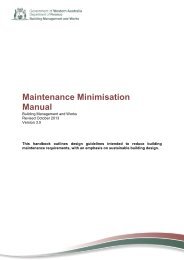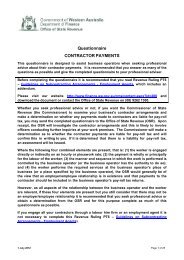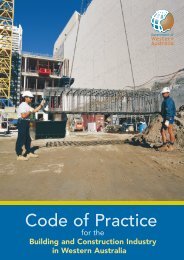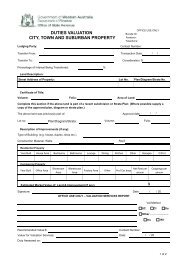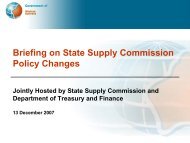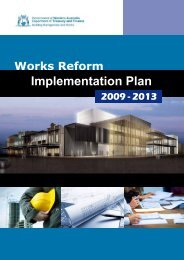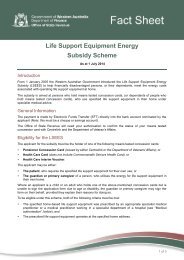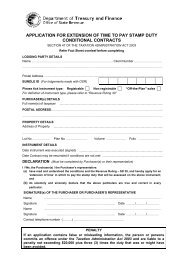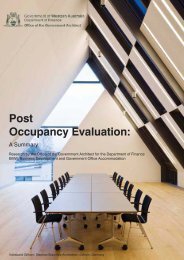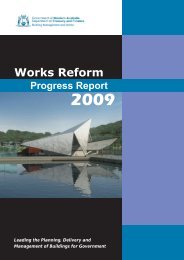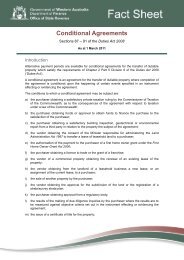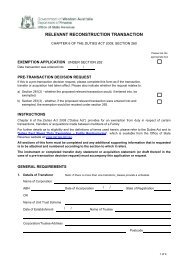Renewable Energy Handbook 2010 - Department of Finance - The ...
Renewable Energy Handbook 2010 - Department of Finance - The ...
Renewable Energy Handbook 2010 - Department of Finance - The ...
You also want an ePaper? Increase the reach of your titles
YUMPU automatically turns print PDFs into web optimized ePapers that Google loves.
A number <strong>of</strong> different assessments will be undertakenduring the feasibility study. <strong>The</strong>se include a siteinvestigation (including data collection); a preliminaryengineering assessment; and a preliminary land use(environmental, heritage and planning) assessment.A site inspection will also be required to obtain thenecessary data to complete the study. Information tobe collected for the feasibility study should include:Project site, infrastructure location and·infrastructure access corridors, includingproximity to sensitive environmental areas;Community issues and concerns;·Physical and legal access to the site;·Details <strong>of</strong> the local transmission network;·Security <strong>of</strong> resource supply, including possible·resource monitoring or audit;Whether the site is deemed prospective for·minerals by the Geological Survey <strong>of</strong>Western Australia;Proximity to a workforce;·Distances to services such as electrical substation·and water;Projected site energy expenditure and consumption;·Preferences regarding the use and/or sale <strong>of</strong>·energy generated; andPreferences regarding project fi nancing and·ownership.<strong>The</strong> preliminary engineering assessment is animportant part <strong>of</strong> the feasibility study. <strong>The</strong> marketshould be canvassed for information on the capitalitems required for the project, such as gas extractionsystems, power generation equipment or windturbines and towers. From the initial data collectionand review, a number <strong>of</strong> technologies will typicallybe selected for technical assessment and economicreview. Factors to consider include:Capital cost estimates, based on Australian·manufacture or transport and import to Australia;Supporting infrastructure costs;·Operation and maintenance costs;·Electrical connection costs;·Revenue streams from sources such as generated·energy and RECs; andLikely environmental impacts and assessment·<strong>of</strong> relevant legislation.OFFICE OF ENERGYRENEWABLE ENERGY HANDBOOK <strong>2010</strong>After identifying all the options for utilising theappropriate technology from a technical andeconomic analysis, the likely environmental andheritage impacts need to be assessed. Similarly,planning policies and legislation will also needto be reviewed to determine the likely land usedevelopment approval process for the project.Following the selection <strong>of</strong> the most appropriatetechnology from a technical, economic andenvironmental perspective, a preferred projectdesign can be developed. It will also be importantto begin preliminary negotiations for a PowerPurchase Agreement for the sale <strong>of</strong> electricitygenerated and any “environmental credits”such as RECs associated with the project.Preliminary discussions with investors are generallyheld during this part <strong>of</strong> the project development.Increased market demand for renewable energyhas stimulated considerable interest in this areafrom the fi nancial sector. Banks, venture capitalistsand other investors, including energy retailers, mayfund renewable energy projects through either theprovision <strong>of</strong> debt or equity, provided that key projectrisks can be appropriately managed. <strong>The</strong> availability<strong>of</strong> this fi nance is a critical element for the development<strong>of</strong> renewable energy projects as the capitalexpenditure requirements can be signifi cant.Projects should be based on commercial viability,however State and Federal Governments may <strong>of</strong>ferother incentives and grants. <strong>The</strong> range <strong>of</strong> fi nancialsupport will change over time and should bereviewed as options in the feasibility study.Some <strong>of</strong> the key risks a project fi nancier mayidentify when undertaking their due diligenceprocesses for a renewable energy facility areoutlined in the Textbox below. <strong>The</strong> table alsodescribes risk mitigation measures that a fi nanciermay require evidence <strong>of</strong> prior to becoming involvedwith the process.29DEVELOPING A RENEWABLE ENERGY PROJECT IN WESTERN AUSTRALIA



